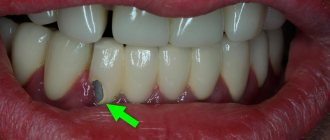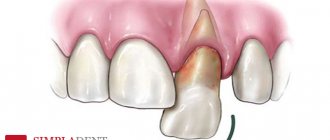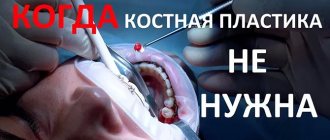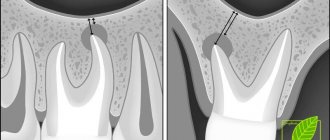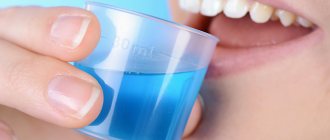How to determine?
There are several signs by which you can immediately understand that a tooth is growing in the wrong direction. This is evidenced by:
- Pain at the end of the dentition.
- Pain and bleeding from mechanical stress, such as brushing teeth or chewing hard food.
- Swelling and hyperemia of the soft tissues near the inside of the cheek.
- Most often, the teething process is delayed for several months or even several years.
- It is visually noticeable that the apex of the tooth is located abnormally.
Why does a wisdom tooth become inflamed?
The cause of inflammation is dental plaque microorganisms. The first sign of inflammation is pain and bleeding of the gums, which usually makes good hygiene difficult. A vicious circle arises: brushing a tooth hurts, but without cleaning it becomes even worse and even more painful. Therefore, the first thing that needs to be done when inflammation occurs in the area of an erupting wisdom tooth is to improve oral hygiene and thus reduce the number of microorganisms to a minimum.
Symptoms of pericoronitis
Sometimes the onset of inflammation around a wisdom tooth can be confused with a cold and a “sore” throat. Patients report that swallowing becomes painful, and the lymph nodes in the angle of the lower jaw and near the ear become enlarged. The pain may radiate to the ear on the side of the problematic tooth. The gum above it swells, changes color to bright red, and purulent discharge may appear from under the gum. There is an unpleasant odor from the mouth.
Symptoms of intoxication of the body are added: fever, chills, weakness, deterioration in general health, lack of appetite. With the development of inflammation, swelling can spread to the cheek and deeper cellular spaces. It becomes difficult to open the mouth, which in turn impairs the doctor’s access to the causative tooth.
Why does a wisdom tooth become inflamed?
What to do?
If a wisdom tooth causes severe discomfort and erupts in the wrong position, it will most likely have to be removed; there is no other solution to the problem. It is better to entrust such complex dental removal to a real professional so that the procedure is carried out according to all the rules. First you need to carry out diagnostics to understand the exact location of the unit. For this purpose, an X-ray of the jaw is performed. Let's consider a step-by-step algorithm for surgical intervention:
- Use of local anesthetic. High-quality long-acting medications are needed, since wisdom tooth removal can take several hours.
- Excision of soft tissue is performed.
- Using a drill to create access to the tooth root.
- Using special forceps, the tooth is removed from the oral cavity.
- The wound is carefully treated with antiseptic agents.
- Stitches are required to stop the bleeding.
Many patients ask the same question: is it possible to leave a tooth in the mouth and not remove it? Experts say that this is quite possible if the new unit does not cause pain or discomfort and does not interfere with neighboring teeth.
Symptoms
In almost all cases, the eruption of the third molar is accompanied by pain. The problem is due to the fact that these elements have no predecessors and they have to make their way to the surface through a thick layer of soft tissue. Minor signs of discomfort are not a reason to panic, but a person should pay closer attention to the problem area.
Photo of a retracted wisdom tooth
Pathology of wisdom tooth growth is determined by the following characteristic symptoms:
- increased bleeding of gums;
- tumors of the gums and cheeks;
- severe pain when chewing food;
- swelling extending to the tongue and throat;
- severe inflammation of the gums in the area of the erupting element and the adjacent tooth;
- discomfort when swallowing;
- injury to the mucous membranes of the inside of the cheek;
- periodic headaches.
An increase in body temperature is less common if the wisdom tooth grows sideways. Relief of this symptom is carried out with the help of painkillers and antipyretic drugs. The eruption of the figure eight can be observed for several years, which entails numerous dental complications. If you experience prolonged discomfort, do not delay visiting your doctor.
Each of the symptoms of the problem should be considered in more detail. One of the most common signs of pathology is swelling and swelling of the gums. Swelling appears even if the wisdom tooth grows in the vertical (correct) direction. Inflammation is due to the fact that the crown makes its way to the surface and injures the soft tissues. Due to injury, the gums increase slightly in size and swell.
The symptom is aggravated if the wisdom tooth grows into the cheek or towards an adjacent element. The element cannot cut through normally due to the peculiarities of its position. As a result, it puts a lot of pressure on the gums, which become swollen, swollen and painful. Along with the gums, the inside of the cheek often swells. You can learn more about the signs of wisdom tooth eruption from this article.
Another sign of abnormal growth of a wisdom tooth is increased bleeding of soft tissues.
Bleeding gums are typical for the horizontal position of the last molars, since in this case the tooth severely injures the gums, cheek, or rests on the seven. The condition is dangerous due to the development of more serious complications - phlegmon, abscess, periostitis, deformation of the bone tissue of the jaw.
Regular friction of the crown of the retained element against the gum tissue leads to the fact that the wounds do not have time to heal and regularly bleed. The symptom is also typical for those situations when the unit erupts towards the tongue. If bleeding occurs in the soft tissues of the mouth, you should immediately consult a doctor.
A crooked tooth can give rise to fever. The symptom is also observed in infants during the growth of primary incisors. In adults, the immune system is more developed, so signs of body hyperthermia during the eruption of figure eights are often absent.
A strong jump in temperature occurs for several reasons:
- Physiological. The body reacts to soft tissue damage.
- Infectious. The symptom signals the proliferation of pathogenic flora in the hood of the wisdom tooth.
In the first case, the patient’s condition stabilizes on its own after a few days. You can relieve the symptoms of the problem with painkillers. The second reason requires professional help, undergoing a set of diagnostic measures and taking antibiotics.
A growing wisdom tooth causes pain when chewing. Discomfort appears at the moment when the rudiment leaves the bone tissue of the jaw and reaches the edge of the gum
When the figure eight tooth is in a horizontal or diagonal position, the signs of pain when eating food become more intense. The pain radiates to the ears, temples or to the lymph nodes. In most cases, there is constant dull or sharp pain.
If you have to resort to potent drugs to relieve symptoms, it is better to consult a doctor. Regular use of such medications negatively affects the condition of the gastrointestinal tract. Treatment with drugs with a powerful therapeutic effect is possible only after consultation with a doctor.
Recommendations after tooth extraction
Removing a complex tooth is considered a full-fledged operation. For this reason, dentists recommend carefully observing the rehabilitation period so as not to provoke the development of complications:
- At the end of the dental procedure, the doctor places a gauze pad. Do not rush to remove it from your mouth; keep the turunda in your mouth for at least 15 minutes.
- When you get home, apply a cool compress to your cheek. This will help avoid severe swelling and soothe the aching pain.
- Do not self-medicate, take only those medications prescribed by the doctor.
- Rinsing the mouth is only permissible on the recommendation of a doctor. As a rule, short-term antiseptic baths are done to prevent the proliferation of pathogenic microflora.
- Monitor your body temperature. If it increases, you should see a dentist.
- Do not heat your tooth under any circumstances. Don't take a bath and limit strenuous physical activity for a week.
- Eat soft foods that can be consumed through a straw.
- If you experience disturbing symptoms, do not ignore going to the doctor.
- If after the end of the painkiller you are in pain, you are allowed to take a painkiller tablet in accordance with the instructions.
Removal
If complications occur, severe pain and incorrect position, the doctor may recommend removal. This is done under local anesthesia after a preliminary examination. It is necessary to undergo a series of studies; the doctor will evaluate the condition and structure of the jaw, the presence of interlacing or curvature of the roots, and other problems. This makes the operation less traumatic for the patient and forgives the dentist’s actions. But even with a preliminary examination, removing eights can become a rather complex process, including the following steps:
- the oral cavity is prepared, the doctor uses local anesthesia for pain relief;
- an incision is made at the site of growth and the tissue is pressed away from the bone;
- using a drill, the doctor drills holes in the bone around the figure eight, which facilitates access and facilitates subsequent removal;
- interroot partitions are sawed (if the roots are entangled, the unit is large);
- all fragments are removed, the wound is washed, a drug is applied to the hole to prevent the development of inflammatory processes and infection;
- stitches are placed on the fabric.
The duration depends on the complexity of the intervention and the condition of the tissues. After the operation is completed and the anesthesia wears off, the patient may feel pain and discomfort. But if you follow the doctor’s recommendations, the pain quickly goes away, and the soft tissues heal quickly.
Recommendations after removal
After removal, the patient must follow a number of recommendations:
- the cotton swab is removed only after twenty minutes after tooth extraction to avoid infection;
- it is necessary to measure the pressure, if it increases, you should take medications to lower it (only under the supervision of a doctor);
- To reduce swelling and pain, you can apply ice compresses to the cheek;
- after the operation, the doctor prescribes antibiotics, which must be taken strictly according to the prescribed regimen, without skipping doses or exceeding the dose;
- It is allowed to take painkillers and injections of lincomycin (as prescribed by the dentist);
- Once a day, the mouth should be rinsed with special products containing chlorhesidine, but this should be done carefully so as not to wash out blood clots;
- It is not recommended to use herbal infusions, as they have little benefit;
- Do not rinse your mouth with hot solutions or use hot compresses, as this will worsen the condition.
On the day after removal, you must give up physical activity and solid food. It is not recommended to disturb the removal site in order to speed up healing and eliminate swelling.
Consequences of pathological growth
If such a process is left to chance, the complications can be very serious. Since the “eight” is forced to push and put pressure on the root “sevens”, which are already tightly seated in their places, such a confrontation can cause inflammation of the periosteum (periostitis), and this, in turn, can provoke osteomyelitis, pericoronitis, and phlegmon.
It is important to know! Mechanical rubbing of the cheek mucosa provokes the formation of a non-healing wound, where infection will sooner or later penetrate. This threatens the formation of a purulent abscess in the soft tissues, which will have to be removed surgically. In addition, an abscess is dangerous because the infection can travel through the lymphatic or bloodstream to any other area of the head and cause inflammation, for example, of the maxillary sinuses, middle ear, and even meningitis.
Another danger is the resorption or destruction of the roots of the “sevens”. When squeezed, blood and, consequently, nutrients stop flowing to them. The roots and tissues of the tooth become weak, leading to early loss of the unit. The pathological growth of the eighth crowns leads to deformation of the gums, which contributes to the growth of plaque and the development of cervical caries in the seventh teeth.
There are cases when inflammation during pathological eruption of wisdom teeth leads to inflammation of the trigeminal nerve. It passes close to the edge of the jaw, so there is a high probability of infection spreading to the nerve fibers.
Removal of a wisdom tooth on the lower jaw
Removing a wisdom tooth (eighth tooth) on the lower jaw is a rather complex task, and not every specialist can perform this procedure efficiently. In some cases, surgical intervention is inevitable, since due to the characteristics of the eruption and growth of wisdom teeth, diseases of the oral cavity may occur. In any case, a decision on the advisability of performing an operation must be made by a qualified doctor, who takes into account not only the patient’s sensations, but also relies on the results of the examination and x-rays. If the dentist still insists on removing the lower wisdom tooth, then it is better to do it as soon as possible to avoid possible complications.
In this article we will look at the most frequently asked questions from patients:
- Formation of wisdom teeth
- Wisdom teeth placement options
- Symptoms of wisdom teeth erupting
- Indications for removal
- Features of the operation
- Preparing for removal
- Difficulties of the procedure
- Patient's feelings during tooth extraction
- Possible complications
- What to do after surgery?
- Removal of the eighth tooth: contraindications
- How much does the operation cost?
- When is extraction of the eighth tooth not required?
Formation of wisdom teeth
Wisdom teeth (third molars) occupy the eighth place in the dentition, which is why they are called “eight teeth.” As a rule, they make themselves felt already in adulthood - approximately from 10 to 25 years. During the process of their eruption and growth, various complications may arise, so in most cases, dentists insist on the procedure of removing the eighth tooth. Often third molars never erupt, meaning they remain impacted. Contrary to popular belief, the formation of wisdom teeth does not occur in utero, but at the age of 4–5 years. Their absence is considered to be a variant of the norm, and not a pathology. “Eights” are vestigial organs that have lost their functional significance during the process of evolution. The third molars are not involved in the chewing process, since the “sevens” take on this mission. Removing a wisdom tooth in the lower jaw is rather a standard procedure, despite all the complications of the operation. In their structure, third molars are practically no different from other teeth, with the exception of the number of roots that hold them in the jaw system. As a rule, “eights” have from two to six roots, while incisors have only one root, and ordinary molars have no more than three.
Most often, the removal of the lower wisdom tooth is necessary, since its eruption and growth occur with complications that are associated with the following characteristics of the body:
- Absence of a socket for a wisdom tooth in the human jaw. During teething and growth, there is no room for the “eight”, which entails a displacement of the main dentition.
- Complete formation of bone tissue in the jaw by age 20. The process of teething is quite painful, and in order to relieve the patient of pain, dentists usually recommend removing the wisdom tooth in the lower jaw.
- Third molars do not have deciduous “predecessors.” This means that favorable conditions for eruption are not prepared.
- The extreme position of the “eights” in the dentition. Since there are no restrictions on one side, the third molar is displaced in most cases.
- Third molars do not perform chewing function. Moreover, they do not participate at all in the processes performed by the jaw. Therefore, the removal of the lower wisdom tooth does not entail any consequences in terms of dysfunction of the jaw system.
Wisdom teeth placement options
Removal of the lower wisdom tooth is carried out after the dentist determines its location in the oral cavity by examining x-ray images. The technique and complexity of the operation directly depend on this. It is customary to distinguish the following options for the location of third molars:
- Medial tilt. The “figure eight” crown is directed towards the seventh tooth.
- Distal tilt. The tooth is deviated back in relation to the main dentition.
- Buccal or lingual tilt. The third molar is directed towards the cheek or tongue.
- Horizontal position. The “figure eight” is located perpendicular to the other teeth.
- Vertical position. The tooth is in a vertical plane at the correct angle, but remains impacted, that is, it has not erupted.
Symptoms of wisdom teeth erupting
Sometimes people do not feel discomfort when cutting through “eights”. However, in most cases this process is accompanied by the following symptoms:
- Swelling of the gums at the site of the cutting tooth.
- Cutting or aching pain radiating to the throat or ear.
- The formation of a “hood” - part of the gum that covers the crown.
- Increased body temperature and general weakness.
- Inflammation of the tonsils and lymph nodes.
If one or more of the listed symptoms is present, the patient is advised to remove a wisdom tooth in the lower jaw.
Indications for removal
According to statistics, about 80% of cases of teething “eights” are accompanied by complications. Sometimes diseases and discomfort that appear against this background can be eliminated using modern methods of treatment or light surgical intervention (for example, incision of the gums). But practice shows that most often the removal of a wisdom tooth in the lower jaw is a necessary procedure. Among the most common indications for extraction of third molars are:
- Carious formations. Osteomyelitis and periodontitis are especially common.
- Displacement of adjacent molars. It can have a negative impact on changes in bite.
- Inflammatory processes in soft tissues (pericoronitis). Inflammation is often observed against the background of difficult eruption.
- Oblique position of third molars. If the “eight” traumatizes the soft gum tissue or mucous membranes, then removal of the lower wisdom tooth is inevitable.
- The appearance of new growths on the roots. If cysts or tumors are detected on the root system, dentists immediately decide to perform an operation.
Timely detection of these problems allows you to avoid many diseases of the oral cavity. If pain occurs, you should immediately contact a dentist who will remove the wisdom tooth in the lower jaw.
Features of the operation
The extraction of third molars is performed by a dental surgeon. If there are certain indications, the doctor may recommend performing the operation under general anesthesia. However, this type of anesthesia is rarely prescribed, since it can lead to side effects. Most often, the removal of teeth in the lower jaw is carried out under local anesthetics - before the procedure, the patient is given injections of novocaine or lidocaine.
If a person is very worried, then it makes sense to take a sedative in advance, which has a calming effect on the central nervous system. In some cases, it is not possible to do without administering a sedative intravenously or using a mask with nitrous oxide.
The lower tooth is removed under sterile conditions using special forceps that allow the third molar to be loosened and extracted. The estimated time of the operation can be up to one hour. If the third molar is positioned correctly, then extracting it is relatively simple - to do this, you need to grab the visible part of the crown with dental forceps. In the presence of caries, curved roots and in cases where the tooth is located under the gum, it is necessary to make an incision into the mucous membrane.
Removing a wisdom tooth in the lower jaw includes several stages. First, an excision of the gum is performed, under which the “figure eight” is located. Next, the doctor removes the covering bone. If necessary, the tooth is divided into several parts. Then part of the crown and roots are removed, the hole is washed, the bleeding is stopped and stitches are applied. The complexity of the operation depends on the characteristics of the body, the structure of the jaw system, the condition of the teeth and the location of the “eights”.
Preparing for removal
If the doctor recommended the removal of a wisdom tooth in the lower jaw, then you need to properly prepare for this. In general, dentists’ recommendations are as follows:
- The optimal time for the operation is the first half of the day. In the morning, the body has enough energy resources to survive the procedure as easily as possible. In addition, after anesthesia, pain almost always appears, which is best dealt with before going to bed at night.
- You should eat before the procedure. After eating, endorphins are released in the body, which help the patient relax. In addition, the blood of a well-fed person clots much faster.
- If you are very nervous, you need to take a sedative before the tooth extraction procedure. Special medications help relieve tension and nervousness.
Difficulties of the procedure
Removing the lower wisdom tooth is associated with some difficulties, which are caused by the structural features of the lower dentition. In this case, the bone is hard and massive, and the alveolus is located in the bone tissue. This means that grasping the crown with forceps and loosening the “eight” is much more difficult than during a similar operation on the upper jaw. The task becomes more complicated if the molar has not completely erupted and only a small part of it is on the surface. Removing a wisdom tooth in the lower jaw is also problematic because it is almost impossible to guess the location and number of roots. It is more difficult for a doctor to work with roots that are bent or intertwined. That is why, before the procedure, the dentist usually sends the patient for x-ray diagnostics. From the image, the surgeon can assess the true structure of the tooth root, thereby eliminating the risk of medical error. Removing a lower wisdom tooth is further complicated by the fact that often the dentist cannot get to the tooth and examine the gum area without additional tools. In some cases, the surgeon takes out the destroyed roots in parts or cuts out the remains of the “eight” using a drill.
Patient's feelings during tooth extraction
Modern methods of anesthesia make it possible to reduce discomfort during surgery to an absolute minimum. The removal of a wisdom tooth in the lower jaw itself is almost painless, since the patient is given anesthetics, and in particularly severe cases, general anesthesia is used. A person begins to feel pain after the procedure, when the anesthesia wears off. Swelling of the face on the side of the removed molar is also considered normal - this is how the body reacts to surgical intervention. As a rule, doctors recommend taking painkillers in the form of tablets or special gels for several days. If the operation is successful, after 2–3 days the discomfort begins to subside.
Possible complications
Removing the lower wisdom tooth can lead to unpleasant consequences, since during the operation it is necessary to cut blood vessels and affect nerves. It is believed that the socket returns to normal within 10–14 days after third molar extraction. Full recovery of the body can take up to eight months. In some cases, complications arise, the most common of which are:
- Painful sensations. If medications do not help, and the pain intensifies every day, then there is reason to assume that an inflammatory process has begun. Be sure to consult a specialist!
- Bleeding. A little bleeding on the first day is considered normal and indicates healing of the wound. Doctors advise refraining from eating, smoking, excessive physical activity, visiting the sauna or taking a hot bath for several hours after surgery. Otherwise, bleeding may increase. In order to stop it, you must first eliminate the provoking factor, and then apply cold to the cheek.
- Temperature. This is the first sign of the manifestation of the inflammatory process. In the first three days, a rise in temperature is acceptable, and dentists recommend taking antipyretics to relieve symptoms. If on the fourth day everything remains unchanged, then you will most likely need treatment with antiseptic and antibacterial drugs prescribed by the doctor.
- Alveolitis. Removal of teeth in the lower jaw may result in suppuration in the socket at the site of the extracted “eight”. Alveolitis is considered a fairly rare disease and appears due to infection in the wound, dental caries, low immunity, periodontal disease, inflammatory processes in the oral cavity, diseases of the upper respiratory tract (sore throat, laryngitis). Alveolitis can also be caused by premature removal of a blood clot from the socket, which leads to its drying out and, as a result, suppuration. That is why dentists prohibit touching the hole until the wound has completely healed and bone tissue has formed in the damaged area.
- Hematoma. A bruise may appear due to increased blood pressure in the patient, as well as injury to the vessel at the site of the extracted molar. The formation of a hematoma can also be caused by capillary fragility, due to the characteristics of the body. As a rule, a hematoma forms a few days after surgery. To eliminate this complication, it is necessary to open the affected area and treat it with an antiseptic. In such cases, antibiotics are usually indicated.
- Paresthesia. Removing a wisdom tooth in the lower jaw is fraught with impaired sensitivity, accompanied by burning or tingling sensations, numbness of the lip or tongue. Most likely, a nerve was damaged during the operation. Paresthesia may persist for up to several months. To eliminate the symptom, the patient is prescribed a vitamin complex and a course of physiotherapy.
What to do after surgery?
Since the removal of the lower tooth often leads to complications, doctors recommend adhering to the following rules after surgery:
- You must refrain from eating, drinking and smoking for two hours after the procedure.
- For the first few days, you should eat soft foods that do not require intense chewing (this could be yogurt, cereal, purees).
- You need to brush your teeth especially carefully to avoid injuring the healing area.
- Avoid foods that are too hot or cold—food and liquids should be at room temperature.
- Reduce physical activity, do not lift heavy objects, refrain from visiting the gym, swimming pool and sauna.
- Make herbal or medicinal baths on the damaged part of the gum, and rinsing is prohibited.
Removal of the eighth tooth: contraindications
Removal of the eighth tooth is contraindicated in the following cases:
- Pregnancy - first and third trimesters.
- Thrombocytopenia, leukemia, hemophilia.
- Nervous and cardiovascular diseases.
- Hepatitis, pancreatitis, glomerulonephritis.
- Diseases of the oral mucosa (for example, stomatitis).
- The presence of malignant tumors in the immediate vicinity of the third molar.
Dentists also recommend refraining from surgery for influenza, ARVI, diphtheria, scarlet fever, dysentery, chicken pox, and measles. In all of the above situations, it is better to postpone the removal of the lower wisdom tooth to a longer period, waiting until the patient’s health returns to normal. When contacting a dentist, you should tell in detail about your health and chronic diseases, if any.
How much does the operation cost?
Removal of teeth in the lower jaw is carried out using special equipment and materials. The cost of the operation is determined individually. The final price varies from several hundred to several thousand rubles and depends on the specific clinic where the tooth extraction is performed, the drugs used, the type of anesthesia, and the complexity of the procedure itself. The doctor can announce the estimated cost after conducting a diagnosis and assessing the overall clinical picture.
When is extraction of the eighth tooth not required?
Removing a wisdom tooth in the lower jaw is a rather controversial issue in modern dentistry. Many people believe that third molars should be removed when the root system is not yet formed, that is, in adolescence. According to this, the operation must be carried out in advance and without fail. In fact, if the “eight” develops normally and does not interfere with the growth of other teeth, then surgery is not required. You can save the “eight” in the following cases:
- The eruption of the third molar occurs normally, without interference or complications.
- It is possible to provide high-quality treatment for figure eight caries.
- The wisdom tooth is not displaced too much, and it can be used as a support for prosthetics.
Under any circumstances, only an experienced dentist can determine how appropriate it is to remove teeth in the lower jaw. Therefore, if you suspect the eruption of third molars, it is necessary to contact a qualified doctor as soon as possible, who will make a final decision based on the diagnosis.
Causes of abnormal growth
“Eights” or, as dentists call them, third molars, are a vestige left over from our ancient ancestors - the Neanderthals. The structure of their skull was different, and their jaw was more elongated, so there was enough room for 16 teeth. Over time, the structure of the head changed, human food became softer, and the jaws stopped protruding strongly forward - the “eights” simply became cramped. Sometimes they literally have nowhere to grow, so they erupt wherever there is at least a little free space. There are frequent cases when a dystopic wisdom tooth begins to grow towards the cheek in both the upper and lower jaws) - you can understand what kind of anomaly this is from the visual photo below.
The pathological process of eruption also arises because the “eights” do not have milk precursors, and therefore, no ready place for growth and location, like the other units of the series. Therefore, they have to pave the way with difficulty, in several stages. For the same reason, in some people, third molars do not grow at all - they either remain in the thickness of the bone or do not form at all.
For your information! In some European and American clinics, doctors remove third molars at the stage of their formation, thus saving patients from the painful periods of eruption of “eights” and possible complications with their growth. Russian dentists do not adhere to this practice, believing that there is no point in removing a healthy “eight”: sometimes when other molars fail, it can become a support for an orthopedic bridge during prosthetics.
Sometimes the cause of a dystopic “eight” can be a pathology of the jaw structure (as a rule, such a defect is inherited) or a non-standard shape of the third molar (too large a crown). You can see in detail what a wisdom tooth looks like growing into the cheek in the photo.
CONSEQUENCES OF THE PROCESS
A long-term process of improper eruption of third molars can cause serious complications, the elimination of which will require long-term treatment and material costs:
- destruction of the roots of adjacent seventh teeth, which leads to their premature loss;
- the appearance of caries and destruction of the enamel of “sevens”;
- the appearance of a focus of inflammation on the cheek;
- the likelihood of inflammatory processes occurring in the bone part, in the gum area and base of the tooth (periostitis, ostomyelitis, phlegmon, pericoronitis);
- compaction of the soft tissues of the gums or cheeks, leading to their modification and degeneration, developing into benign or malignant neoplasms.
To avoid complications, you should contact a dental clinic as soon as possible. Only a comprehensive examination can predict the development of the eruption process and give recommendations on possible removal or treatment of a wisdom tooth.
In many countries, modern dentistry offers the removal of “eights” at the formation stage at a young age in order to save people from possible pain and complications.

